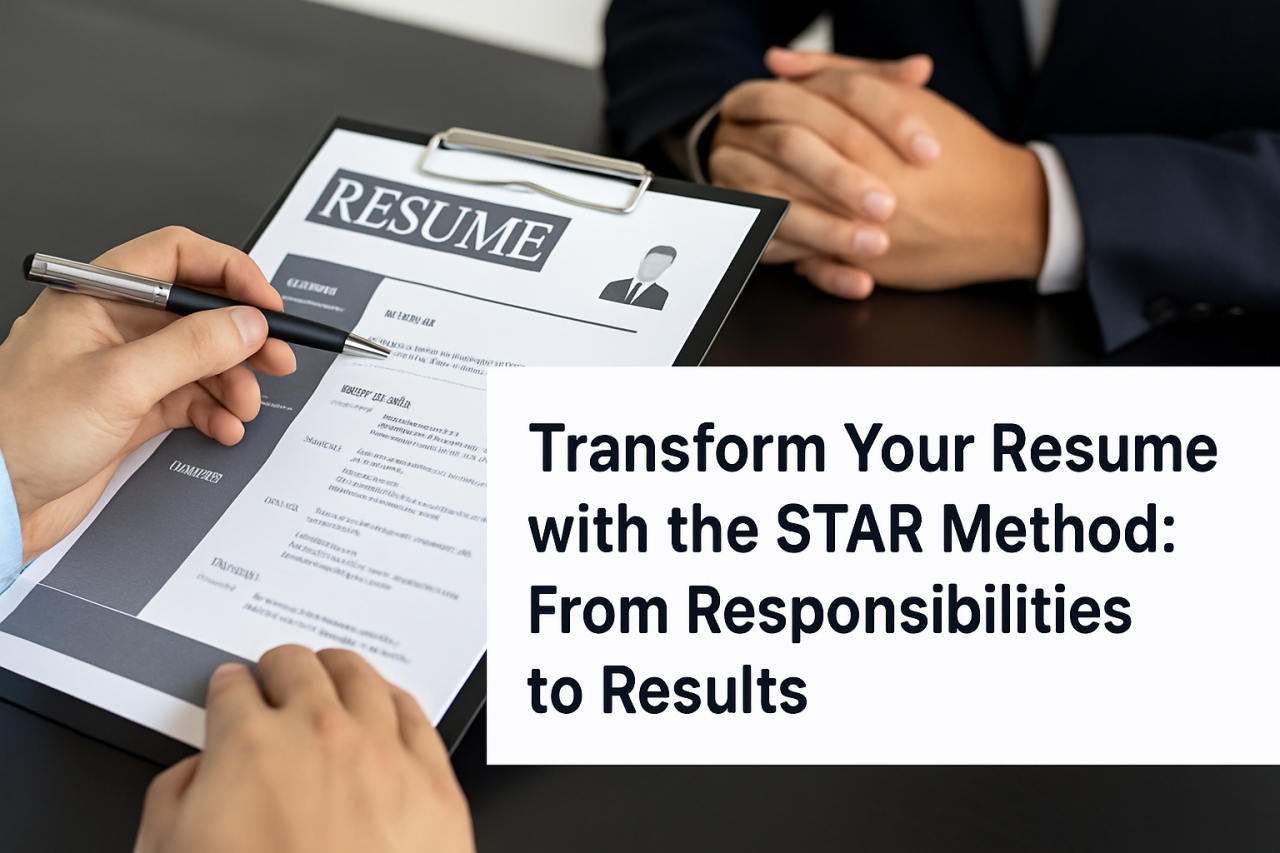Transform Your Resume with the STAR Method: From Responsibilities to Results

Learn how to use the STAR method on your resume to showcase achievements, turn responsibilities into results, and impress recruiters.

You're staring at a blank resume, trying to transform your work experience from a list of duties into something that shouts "Hire me!" We've all been there. Traditional resume bullet points often fall flat, merely listing responsibilities without showcasing your true impact.
But what if there was a way to turn those ordinary job descriptions into compelling, achievement-driven statements that grab a recruiter’s attention?
Originally a secret weapon for acing behavioral interviews, the STAR method (Situation, Task, Action, Result) is now revolutionizing how job seekers write their resumes. It's the ultimate framework for turning generic tasks into powerful accomplishments that highlight your skills and measurable achievements.
In this blog, we’ll show you how the STAR method can transform your resume, with real examples, actionable writing tips, and guidance on applying this technique across multiple resume sections. You’ll also learn how ATVM Workforce Solution’s resume development support can help you build STAR-powered bullet points that make your profile stand out to recruiters.
What is the STAR Method?
The STAR method is a storytelling technique originally designed to answer behavioral interview questions. But its structure—Situation, Task, Action, Result—makes it a perfect fit for writing impactful resume content.
- Situation – What was the context or background?
- Task – What was your responsibility or objective?
- Action – What steps did you take to handle the task?
- Result – What outcome did your actions lead to?
This format forces you to go beyond simply listing what you did. Instead, it helps you tell a short, structured story that shows how your contributions made a difference.
Why Use STAR for Resume Bullet Points?
✔ Clarity and Context
Each bullet becomes a micro-narrative—giving recruiters a quick snapshot of the challenge, your role, and the outcome.
✔ Built-in ATS Optimization
Detailing tasks and results naturally incorporates keywords from job descriptions, improving your chances of getting past Applicant Tracking Systems.
✔ Focus on Impact, Not Just Duties
STAR helps you prove your value with results, not just responsibilities.
✔ Easy to Quantify Achievements
It encourages you to use data—% increase, time saved, revenue earned—which makes your accomplishments credible and memorable.
✔ Perfect for Any Role
Whether you're in project management, sales, tech, or even academic work, STAR helps you tell a better professional story.
How to Write a STAR Bullet Point
Here’s the formula:
Situation – What was going on?
Task – What were you expected to do?
Action – What did you actually do?
Result – What happened because of your actions?
Example:
Before (basic): “Handled onboarding for new employees.”
After (STAR): “Redesigned onboarding flow to include automated welcome emails and interactive training sessions, improving new hire satisfaction by 34% and cutting ramp-up time by 15%.”
Where to Use STAR on Your Resume
- Work Experience – Use it for every job you've held to showcase contributions.
- Internships/Volunteering – Highlight skills and impact, not just participation.
- Freelance/Consulting – Outline client problems, your actions, and outcomes.
- Academic/Leadership Projects – Show how you applied your learning and drove change.
Tips for Powerful STAR Bullet Points
- Use strong action verbs: “Implemented,” “Led,” “Optimized,” “Streamlined.”
- Focus on results: Don’t just say what you did—say what happened because of it.
- Keep it short: Ideally, each bullet should be 1–2 lines.
- Be specific: Avoid vague words like “helped” or “assisted.”
- Use numbers: Quantify results wherever possible.
STAR Bullet Point Variations
Result-First:
“Boosted customer retention by 15% by launching a personalized email campaign for at-risk accounts.”
Action-First:
“Automated reporting tasks using Excel macros, saving 20 hours/week and improving data accuracy.”
Classic STAR:
“During a high-risk migration project, I led the data transfer and user training for 50+ employees, achieving 99% data accuracy and zero downtime.”
Common Mistakes to Avoid
- Writing a paragraph instead of a bullet point
- Being vague or generic
- Inflating results beyond what’s credible
- Ignoring the job description’s keywords
Examples by Role
Sales:
“Introduced lead-scoring system, improving sales conversion by 18% in under 3 months.”
Project Management:
“Led cross-functional team to deliver product launch 2 weeks early and 10% under budget.”
Tech (Developer/Analyst):
“Created dashboard using Python & Tableau, reducing reporting time by 40% and increasing insight accuracy.”
Academic/Fresher:
“Organized university coding event for 60+ students, resulting in 95% satisfaction rate and 30% rise in club participation.”

Bonus: STAR Helps with Interviews Too
Your STAR resume bullet points double as ready-to-go answers for common interview questions. When asked to “describe a time when...”, you’ll have a story already written, practiced, and quantified.
Need Help Creating a STAR Resume?
At ATVM Workforce Solution, we guide job seekers through crafting resumes that reflect not just what they’ve done—but how they’ve made a difference. If you want support in rewriting your resume with STAR bullet points, connect with our resume support team today.
Don’t just apply—impress. Start transforming your resume now.
Categories: : Resume
 Kalaivani Ramprasad
Kalaivani Ramprasad 